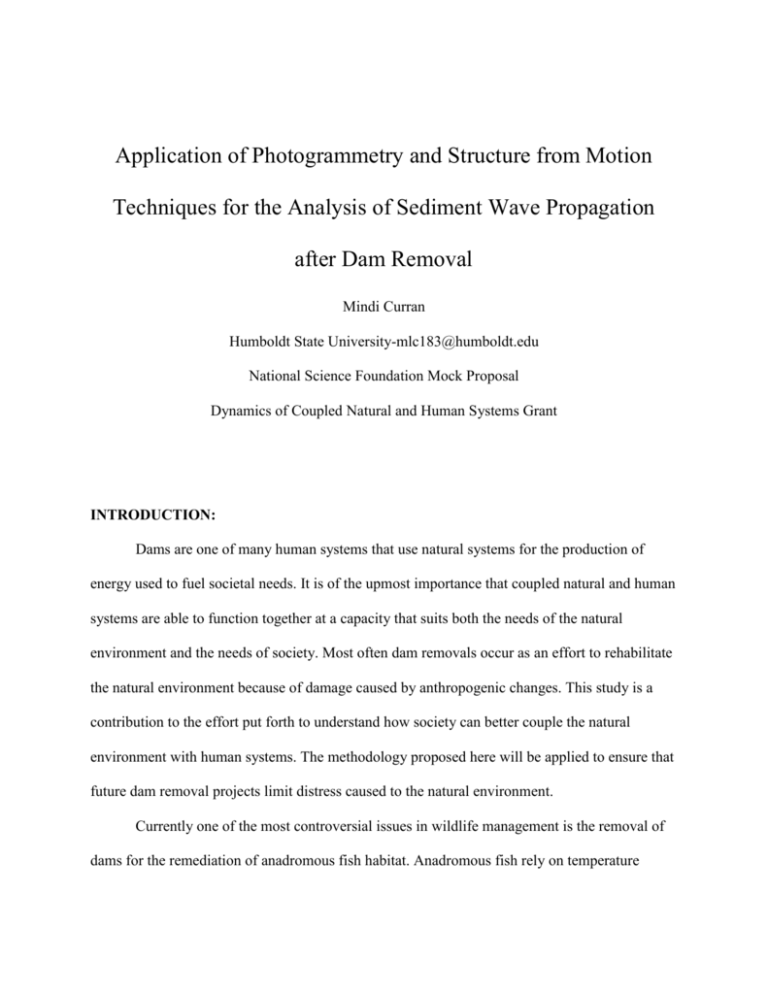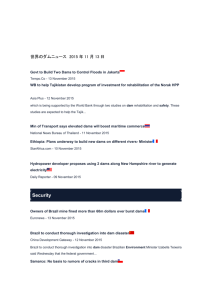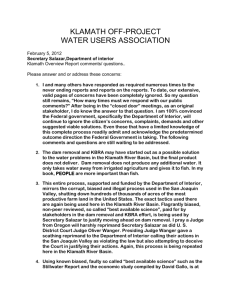Application of Photogrammetry and Structure from Motion
advertisement

Application of Photogrammetry and Structure from Motion Techniques for the Analysis of Sediment Wave Propagation after Dam Removal Mindi Curran Humboldt State University-mlc183@humboldt.edu National Science Foundation Mock Proposal Dynamics of Coupled Natural and Human Systems Grant INTRODUCTION: Dams are one of many human systems that use natural systems for the production of energy used to fuel societal needs. It is of the upmost importance that coupled natural and human systems are able to function together at a capacity that suits both the needs of the natural environment and the needs of society. Most often dam removals occur as an effort to rehabilitate the natural environment because of damage caused by anthropogenic changes. This study is a contribution to the effort put forth to understand how society can better couple the natural environment with human systems. The methodology proposed here will be applied to ensure that future dam removal projects limit distress caused to the natural environment. Currently one of the most controversial issues in wildlife management is the removal of dams for the remediation of anadromous fish habitat. Anadromous fish rely on temperature thresholds, baseflows, and spawning gravels, all of which are often disrupted or completely destroyed on rivers with dams. One major issue concerning dam removals is determining how accumulated sediment behind dams will disrupt the stream environment and for how long. In order to make estimates about habitat disruption we must first determine how sediment waves propagate and distribute through riverine environments. This study will focus on using structure from motion photogrammetry to understand the spatial and temporal dynamics of a sediment wave released after dam removal on the Klamath River. This research will address the question: “Is sediment wave propagation occurring as a translational, stationary, or dispersive wave, and what is the channel response”? This analysis will allow researchers to understand how the channel is transporting and storing sediment which ultimately determines the success of anadromous fish reproduction. SETTING AND BACKGROUND: Historically, the Klamath River was one of the most biologically productive rivers in the western United States with an average population of 880,000 spawning salmon per year (1). The mainstem Klamath River’s headwaters are in the Cascade Range near Klamath Falls, Oregon. The mainstem stretches for 263 miles to the mouth in northern California near the unincorporated community of Klamath, California. Native American communities have lived and used resources along the river for over 4,500 years. Since the gold rush and colonial settlement of the late 1800s water rights, irrigation rights, and litigation revolving around salmon have been a constant problem on the Klamath River (1). Construction of the first hydroelectric dam began in 1913 by the California and Oregon Electric Company 198 miles upstream of the mouth of the Klamath River. This dam, named Copco 1, was completed in 1918 followed soon by the completion of the dam Copco 2 in 1925. With no constructed fish passage, these dams effectively blocked 175 miles of upper Klamath River watershed to anadromous fish passage. In 1952 the Big Bend Dam was constructed 25 miles upstream of the Copco dams, increasing the total possible productivity of electricity to 80 megawatts. In 1961 the Pacificorp Company came into ownership of the Klamath Hydroelectric Project including the three dams that had been built. In 1962 Pacificorp completed construction on their final dam, Iron Gate, downstream of the Copco dams. Today, the dams together average 81 megawatts powering 1,400 farms and 70,000 homes. Including the mainstem Klamath River, tributaries, and headwaters, these dams block a total of 300 miles of habitat for anadromous fish (1). Pacificorp’s dams are licensed through the Federal Energy Regulatory Commission (FERC). License renewal began in 2004 and after determining that upgrading the dams to the new environmental standard was ultimately not cost effective, dam removal became an option. In 2010 the Klamath Basin Restoration Agreement was signed by Pacificorp and the federal government concluding that the dam removal process of all four dams would begin in 2020. However, due to conflict between shareholders and the inability to settle the resource rights it is still uncertain if the federal government will follow through with dam removal. The area of focus is a local reach of Klamath River approximately () miles downstream of the farthest downstream dam, Iron Gate. RESEARCH PLAN: Data processing will take place at Humboldt State University in the Geology Department. Computer and lab facilities will be used along with contributions from students and staff. According to (BLM) photogrammetry is the art, science, and technology of obtaining reliable information about physical objects and the environment through the process of recording, measuring, and interpreting photographic images and patterns of electromagnetic radiant energy and other phenomena. Essentially, photographs of an object are taken at different angles and then uploaded into a program such as Agisoft Photoscan which then mathematically connects the pixels of each picture to create a three dimensional representation of the object. These techniques can be applied to any scale in which the researcher needs. For this analysis a drone with attached camera will be used to take aerial photographs of gravel bars. Ten large gravel bars along with ten sections of the submerged channel will be photographed for the analysis. Agisoft Photoscan will then be used to create “dense clouds” which are point clouds of the data. Dense clouds are essentially the uninterpolated version of a Digital Elevation Model. Baseline data will be collected for the bars the year prior to dam removal. This is necessary to establish the elevation of the gravel bars prior to the sediment wave transporting through the system after dam removal. Subsequent photographing will occur for each bar and channel area once a month for the next year and dense clouds will be created for each photomonitoring effort. At the end of the year these dense clouds will be uploaded into Cloud Compare, a dense cloud processing program that will overlay all of the dense clouds and calculate the elevation differences between them. This will produce the changes in elevation that occurred on the gravel bars over that year as the sediment wave that was stored behind the dam begins to propagate through the reach. This will allow for the analysis of sediment wave propagation. The particle size distribution can be calculated and along with the change in bar elevation and morphology differences the rate of dispersal can be calculated along with an analysis of how quickly the wave is traveling. It is critical for anadromous fish habitat that the sediment doesn’t suffocate the system. This analysis will allow for a qualitative effort at predicting the risk of this happening. One of the major issues of studying sediment waves has been the inability to measure elevation changes of bars and beds at the resolution necessary to track sediment wave propagation (Lisle 1997). The photogrammetry described here is a cost effective method that provides the resolution required to track subtle elevation changes in great detail. According to Matthews (2008), if the correct workflow is used, a resolution of 0.25mm and a spatial accuracy equivalent of 0.025mm can be achieved. Other methods have also recently shown great advancements in creating DEMs, including terrestrial LiDAR. However, terrestrial LiDAR is orders of magnitude more expensive than photogrammetry and cannot be used on a landscape covered by water. For example, Westoby et al. (2012) applied both the photogrammetry technique and terrestrial LiDAR to three study locations and found that photogrammetry paired with software similar to Agisoft Photoscan produces better resolution than terrestrial LiDAR. A preliminary test of the photogrammetric methods was completed in September 2015 on Jacoby Creek, at Brookside Bridge, Arcata, CA. A one square meter area on a section of submerged gravel bar was used as a test site. Twenty seven photographs were taken at different angles of the area and then analyzed in Agisoft Photoscan to produce a dense cloud. At the Jacoby Creek site, a one square meter area was used because the purpose of the test was to evaluate if photogrammetry is possible on a submerged bar. On the Klamath River, the study sites will be much larger (on the order of tens of meters) to capture expected sediment deposition along the full bar length and full channel width. Figure 1. Preliminary test results from Jacoby Creek in Arcata CA. Top figure shows the dense cloud created from data points using Agisoft Photoscan. Bottom figure shows how the dense cloud can be used to create a terrain model a gravel bars surface. The square of blue tape is exactly one square meter. OUTREACH: Two educational conferences will be held at the Humboldt State University campus aimed at informing the general public, students, and leaders in industry of the importance of maintaining anodromous fish habitat. The conferences will be held six months apart the third year of the project so some results can be shown. There will be a variety of discussion sections that will cumulatively make up the conference. Discussion topics include but are not limited to: 1) The application of photogrammetry in geomorphology, 2) Basics of anodromous fish habitat and the reasons why it’s threatened, 3) History of the Klamath River and future directions. In addition to the educational conferences a special weekend workshop and project will be held at Humboldt State University for professors and students to become familiar with photogrammetric techniques and applications. The workshop will inform attendees about different scales that this technology can be applied to and ideas on how they can apply it in their individual fields. This workshop will allow the attendees to practice taking photos, upload them to Agisoft, and make calculation differences in Cloud Compare. The workshop will be held on two separate occasions, also during the third year of this project. BUDGET The items included in the budget are imperative to the success of this project and are listed below in a table. The salary will ensure that the researcher has full time dedication to this work. The graduate and or undergraduate students are necessary assistants for data collection and processing. The drone, camera, computer, and software are the primary equiptment needed for the photogrammetric analysis and data processing. Cloud Compare is free software so it is not included. The publishing and conference costs will ensure that the research is displayed so it can be contributed to the science. Researcher Salary $30,000 per year Salary Graduate Student Assistants $6,000 per year each Graduate students or (2) undergraduate students that help process data Computer $5,000 one time Computer with high storage capacity and RAM Agisoft Photoscan $2,000 one time Needed for photo processing Camera $500 one time Camera needed for photogrammetry Drone $3,000 one time Arial drone to mount camera on Specialized Scale Bars $500 one time Scale bars designed by the BLM and automatically recognized in Agisoft Conference Costs $1,000 twice For the presentation of research along with food, lodging, travel costs Publishing Costs $400 Fees for submitting the research for publication RESEARCH SIGNIFICANCE: The application of photogrammetry is a potential way to quantify the effects of sediment wave propagation in rivers and streams that are critical to healthy fish habitat. This work could inform future dam removal projects, gravel augmentation projects, and habitat remediation projects specifically by: 1) improving understanding of how large amounts of material move through river systems, which can help on managed rivers to limit habitat disruption , 2) improving understanding of sediment wave propagation, which can make more accurate predictions of how much, when, and where to introduce sediment, and 3) development of a photogrammetric methodology for studying sediment transport, which opens new avenues for the application of this technology in fluvial geomorphology and habitat restoration. REFERENCES: Blumm, M.C. and Erickson, A.B., 2012. Dam Removal in the Pacific Northwest: Lessons for the Nation. Environmental Law, 42. Lisle, Thomas E. 1997. Understanding the role of sediment waves and channel conditions over time and space. What is Watershed Stability: 23-25. Matthews, N. A. 2008. Aerial and close-range photogrammetric technology: providing resource documentation, interpretation, and preservation. Technical Note 428. U.S. Department of the Interior, Bureau of Land Management, National Operations Center, Denver, Colorado: 1-42. Westoby, M. J., Brasington, J., Glasser, N. F., Hambrey, M. J., & Reynolds, J. M. 2012. ‘Structure-from-Motion’photogrammetry: A low-cost, effective tool for geoscience applications. Geomorphology, 179: 300-314.








